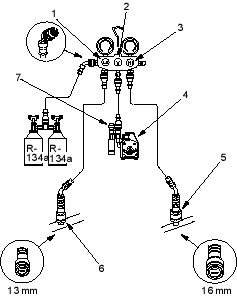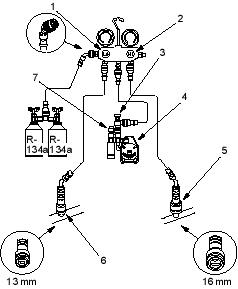|
|
|
- Use only a gauge set for refrigerant HFC-134a (R-134a).
- Use a vacuum pump adapter which is equipped with a check valve to prevent the backflow of the vacuum pump oil.
If accidental system discharge occurs, ventilate work area before resuming service.
R-134a service equipment or vehicle air conditioning systems should not be pressure tested or leak tested with compressed air.
Additional health and safety information may be obtained from the refrigerant and lubricant manufacturers.
- Close the evacuation valve (two valve gauge: evacuation stop valve).
THREE VALVE GAUGE

- LOW-PRESSURE VALVE
- EVACUATION VALVE
- HIGH-PRESSURE VALVE
- VACUUM PUMP
- HIGH-PRESSURE QUICK JOINT
- LOW-PRESSURE QUICK JOINT
- CHECK VALVE

- LOW-PRESSURE VALVE
- HIGH-PRESSURE VALVE
- EVACUATION STOP VALVE
- VACUUM PUMP
- HIGH-PRESSURE QUICK JOINT
- LOW-PRESSURE QUICK JOINT
- CHECK VALVE
- Open the cans.
- Open the high-pressure valve to charge the system to about 98 kPa (1.0 kgf/cm2, 14 psi), then close it. Close the low-pressure valve.
- Check the system for leaks using a leak detector proper to refrigerant R-134a. Particularly check for leaks around the compressor, condenser and receiver/dryer.
- If you find any leaks, tighten the joint nuts and bolts to the specified torque.
- Recheck the system for leaks using a leak detector.
- If you find leaks that require the system to be opened (to repair or replace hoses, fittings, etc.), release any charge in the system.
- After checking and repairing leaks, the system must be evacuated (see page 21-95).
 CAUTION
CAUTION

